In the ongoing quest to review the best snowmobiles and gear here is a detailed report on the Ski-Doo Backcountry X-RS 850 vs Renegade X-RS 900 Turbo
I stopped in to Lemieux Garage in Colebrook NH on Presidents Day weekend and asked what was new and exciting from the brain trust up north in Valcourt, Quebec. Without hesitation they steered me to the 2020 Ski-Doo Backcountry 850 X-RS and a lime green Ski-Doo Renegade 900 Ace Turbo.

Honestly, I was at first disappointed in the opportunity to ride the Backcountry, as it’s not a sled a groomed trail rider would be interested in. Or would it? I did trail test the 900 Ace Turbo last year. The Renegade 900 Turbo is a terrific sled and I was smitten by its charm, so I was pleased to ride it again to confirm my findings from last year and if possible do a comparison of sorts to the 850 Backcountry. How good can life get?
Ski-Doo Backcountry X-RS 850 Features
I zoomed right in on the Backcountry crossover simply because the 850 motor is new to me, and let’s face it, ultra-long track machines are not commonplace in the Northeast.
I tried to wrestle in my mind the negative aspects of a long track for groomed trail riding. It’s going to push, the two-inch lugs are going to make tons of vibration at speed, not to mention the narrow-sculpted seat is too small for all day comfort, the low windshield is a no-go etc… etc.

Okay, let’s give it a shot, have an open mind, what have I got to lose? Andre, the service tech, gave a complete overview, including the optional SHOT starter, the digital gauge and handlebar functions and how to change the belt. It was now go-time.
What would I like, dislike? I soon found out is that it was best to remove the garbage from my head and “just ride it” like that Nike commercial preaches. Really.
Ski-Doo Color Choices
The first visual of the sled is the color scheme. It’s new, loud, and in your face. The statement that Ski-Doo wanted to make to the snowmobile community was: “watch out, here I come, you better make way!”
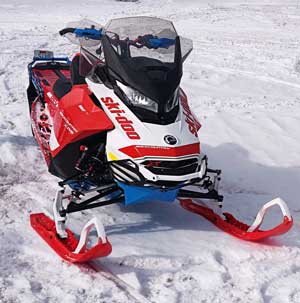
While the tomato-red with matching skis and white hood wouldn’t be my first color choice, it was still was easy to look at and something I could get used to. Different color options are available for 2021.
I applaud Ski-Doo for their multi-colored schemes across the entire lineup and not painting everything yellow and black. It’s marketing at its best to attract a broad spectrum of age groups and with that I think they have succeeded. Sales numbers don’t lie and this one fact alone will keep Ski-Doo, once again, at the top of the heap at years end.
X-RS Gauges and Controls
After starting the machine, I began playing with the gauge functions. Clear and done very tastefully is how to describe the gauge pod. There was a clean and unobstructed view of gas level, coolant temp and handlebar-thumb heater intensity. As one sits on the seat it’s easy to see the pod.
BRP has done a nice job in routing cables and wires to accommodate rider visuals. Interestingly they couldn’t leave well enough alone and have changed the pod yet again for certain 2021 models.
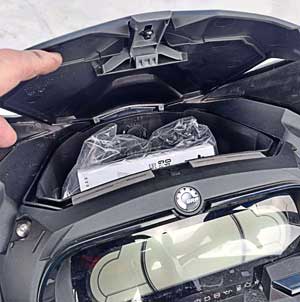
There are two things I would like to see all manufacturers add to gauge pods, color and an ambient temp gauge. Yup, I really do want to know when its twenty below zero! Both Ski-Doo and Polaris have introduced color gauges on some 2021 sleds.
The handlebar buttons are clearly laid out so you don’t have to read directions or be a member of Mensa to find the desired function. The handlebar warmers function as you would expect and yet are too hot on high.
Why is this? When its 20-below zero and you start the machine first thing in the morning it’s your best friend to have toasty handlebars, that’s why. Also, folks with circulatory issues or females tend to ride colder overall and would want hotter controls as well.
SHOT Starter Option
The SHOT starter button and reverse are one in the same, as in other BRP rides. Push to start and while running push for reverse.
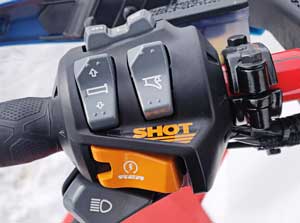
The SHOT starter replaces the traditional battery, starter solenoid, starter and wires associated with electric cranking. It saves at least 20 pounds over traditional electric start.
Essentially, you start the sled once in the morning by pull-start.
The running engine then charges a super capacitor. Subsequent starts are a push button affair off the capacitor, no pull start required.
Could they at least make the ultracapacitor hold that voltage until the next morning? It worked flawlessly on my extended demo and as I always state, light is right!
Brembo Brakes
I found the Brembo brakes to be quite good, although somewhat grabby. Once again, I find the lever too short. I’m old school and still remember the days of cable brakes and the death grip you had to apply to stop.
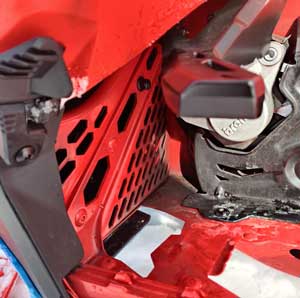
It’s a two-finger lever only and it really pulls the sled down quite smartly, especially with the added stopping power of the two-inch track. Just a light feathery feel gets the job done.
I wish manufactures would produce anti-lock brakes for snowmobiles. This would be huge as it would allow for straight-line stops as opposed to skidding sideways. Right now, rider options are to pump the brakes in panic situations.
The tether was redesigned a few years ago with a strong four-prong grip that move a few degrees in any direction so that bumps during snow maneuvers won’t kill the engine.
The throttle is an easy pull and is not fly-by-wire system like the Turbo Ace. Thank you on that one.
There are hand guards which block the wind quite nicely and low windshield which looks sporty and fits well. The handlebar grips are tacky and smaller in diameter with just the right amount of curve at each end.
Backcountry Track Length
What are other features of the machine are noteworthy? Track length is 146-inches long with two-inch powder lugs. Not something I would pick for a touring sled but the traction gained is just plain phenomenal.
Groomed hills are no match for this profile track. Normally when going up steep hills, where the snow is pushed to the side, you would get deeper into the throttle, spin the track, and dig up the trail. Not this track. It just plain grips and goes with no added throttle whatsoever. I like it.
Backcountry Renegade XRS Suspension

The RAS 3 front end with KYB Pro adjustable shocks is wider than mountain sleds but narrower than a trail sled.
By means of two knobs, one top one bottom, you can adjust shock stiffness and rebound. More on that later.
The rear suspension is uncoupled so in deep snow excursions you can lift the front end at will.
There is also a clicker adjustment on the center shock, making it a well-rounded package.
Rotax 850
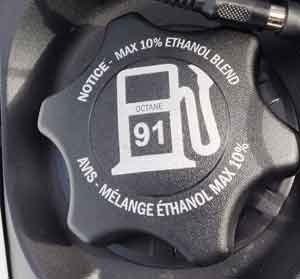
The 850 two-stroke has been around for a few years, filling a high-performance gap that was missing previously in the Ski-Doo lineup. Its 91 octane and pure performance.
I can’t speak to gas mileage, as the machine had 23% break-in left on the clock before full potential.
Obviously, a lot is dependent on how often and hard you mash the throttle. Many riders report 14-20 MPG with many claiming 18 as the average.
Real World Test
Now for the good stuff…what you expect a real-world test to be. Was it trailable? Worthy of a touring rider’s consideration? Did it push in corners? Does the 850 overwhelm the chassis?
I’m here to tell you that this machine is a game changer in the touring arena. Yes, that’s right, call the Canadian Mounties, shout it out on the New Hampshire mountaintops if you wish, this crossover really rocked my boat. Honestly.
I was asked by Bobby, the owner of Lemieux’s, what I thought of the sled. I told him I did not want to bring it back and I really meant it.
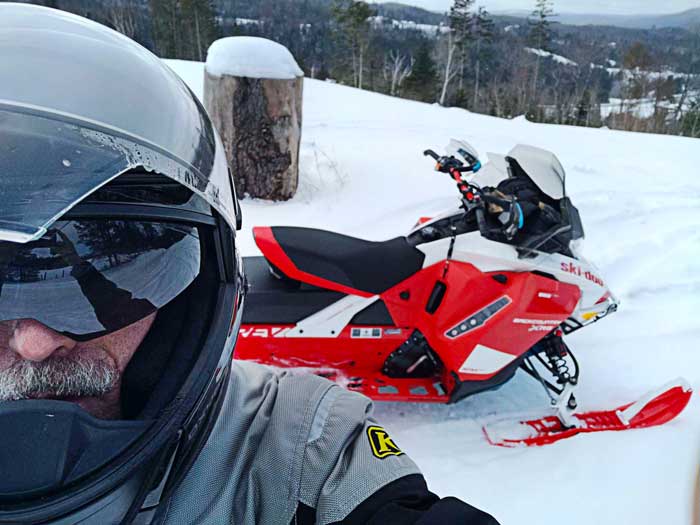
I was grinning ear to ear while riding, in a way I hadn’t in years. Not that my existing 129-inch sled was bad, mind you, but this new technology threw the beat down for a complete and total package.
Why? Quite simply because of the two standout features working in sync together. Specifically, the RAS front end’s ability to carve corners precisely and the long track’s ability to absorb all kinds of junk.
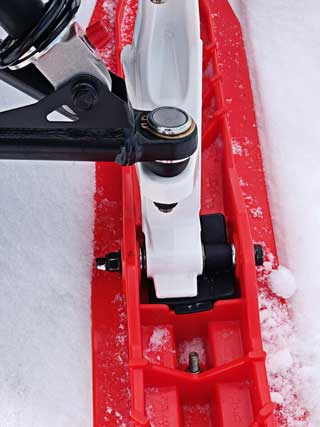
Forget what you know about long track sleds wanting to push you around in the corners. The secret here is the last 10 or so inches of slide rail are tipped up in the rear, so effectively you get about a 137 footprint on the trail. The rest of the rail is used in the deep stuff where the bias is naturally towards the rear anyway and the front end is pointed upwards. Genius.
Ski-Doo is not the first to do this but they may be one of the best at putting all the pieces together so that it just plain works. Take that, you long track skeptics! I’ll have to ride the other manufacturers sleds to see what their answer is to this particular platform.
The precision front end gave me 100% confidence that the machine would absolutely, positively, go where I pointed it. Only icy corners tripped it up somewhat but that is to be expected.
The light feeling I got when turning the handlebars felt like power assist under the hood. I thought for a moment that BRP threw a one-off special sled at us that would never see the light of day. No heavy-weighted tired at the end of day feeling. No sir, no way.
Adjusting KYB Shocks
Initially the front shocks were way too stiff so I turned the top dial in to adjust rebound and matched it with the soft setting on the bottom knob. This brought those annoying closely spaced jigglers under control. Going over bombed out trails was fun as the long track, even with the rails tipped up, would go in and out of the moguls with almost no fanfare whatsoever.
That 146 just bridges those bumps oh so well. I watched as newer 129 and 137 sleds ahead of me bounced up and down like bobble heads over the same jigglers while the Backcountry just went through with ease.
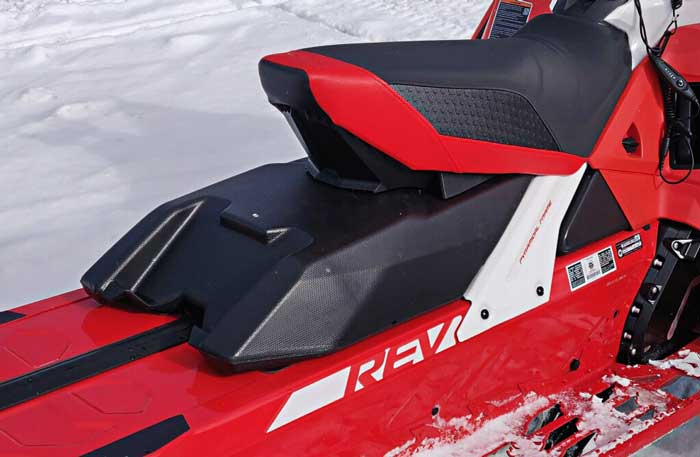
The seat, although comfortable and well padded, was not big enough for me to skootch around during a 200-plus mile day, nor was it heated, which I would miss greatly. It’s not a deal breaker but something you will have to decide what you like.
The 850 motor was powerful up to the mid-range but I could feel it holding back at top end, no doubt due to the 23% break-in still left on the clock. Even with the reduced output, I would rate the power in line with a very strong 800.
I’m sure that will change once the clock strikes midnight. Due to its two-stroke design power really comes on at around 5,500 after engagement at 3200 RPM.
Backcountry Track Options
I’d consider spec’ing this sled with the 1.6-inch Ice Cobra track, as I’m a trail rider. That would still be more than enough for those two-foot dumps of fresh snow on the next saddlebag trip. Take note that at higher trail speeds not one bit of vibration was felt with the two-inch lugs but I’m sure top end suffers. My build sheet for this machine would be $16,366. That includes the extra high windshield, electric start, knee pads and heated shield outlet.
Ski-Doo Renegade 900 ACE Turbo
How does the Renegade 900 ACE Turbo stack-up against the 850 Backcountry in the touring department? Let’s start with the track and suspension. The 137 track on the Ski-Doo Renegade bridges the bumps well and has very good compliance but the Backcountry just seems to be that much better without coupling or rMotion technology.
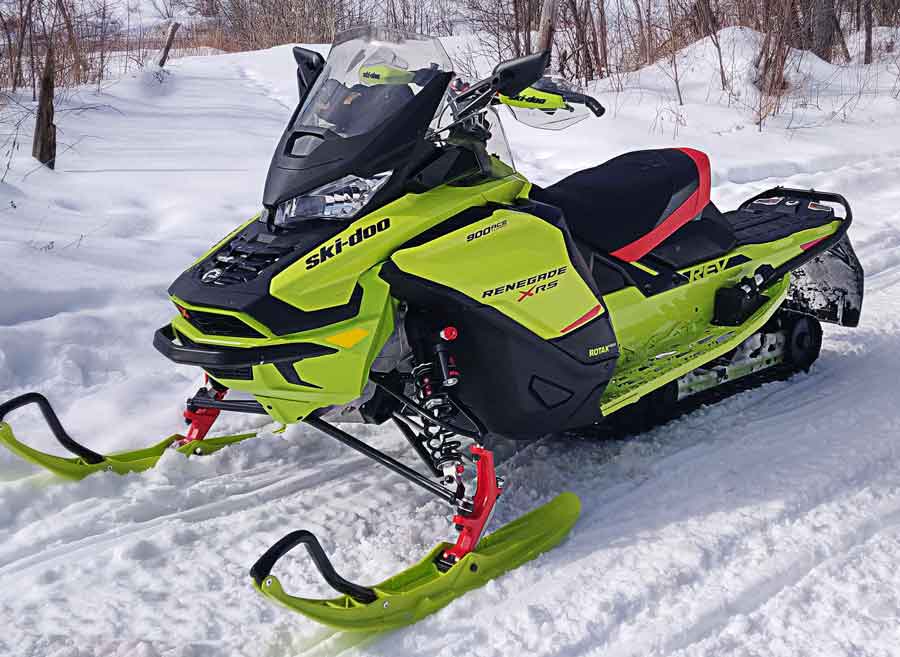
Not that it happens often but unforeseen off-trail excursions would make it easier to get unstuck with the Backcountry’s deeper profile track and add additional confidence after a two-foot dump of snow and no groomer in sight. The deeper lug choices are better on the Backcountry as well.
If I had 100-acres of land or permission from a local landowner to ride off-trail, the Backcountry would be my weapon of choice. Top speed would be lower on the Backcountry on those long rail grades, forest service roads or lakes, if that’s a consideration. Still… check one for Backcountry.
Comparing Ski-Doo Seats
The seating position and comfort on the Renegade X-RS 900 Ace Turbo is excellent but for some unknown reason I thought the Backcountry X-RS felt higher and even more forward. Thus, giving me a more balanced and confident feel.
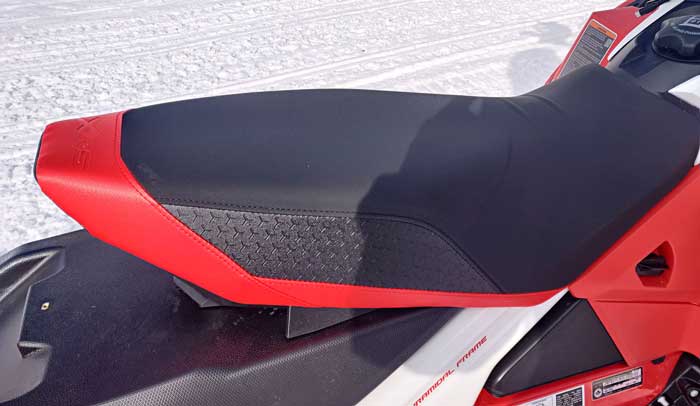
The Renegade has a heated seat option and the saddle is bigger. The seat on the Backcountry is small and narrow but the material and foam density were terrific. Check one for the Renegade.
Rotax 900 ACE Turbo Four-Stroke vs 850 E-TEC Two-Stroke
Comparing the turbo four-stroke versus the big two-stroke is interesting. The 900 ACE Turbo has plenty of muscle and is far less fussy with gas quality and (bonus points) no annoying containers of oil to bring along, not to mention more lower-end power.
Unfortunately, the turbo has that annoying throttle-by-wire function that just feels disconnected from the engine. It has an on/off sensation, lagging in response. I had to take it out of sport mode in town or tight spaces just to feel in control. Hopefully Ski-Doo will come out with a re-flash.
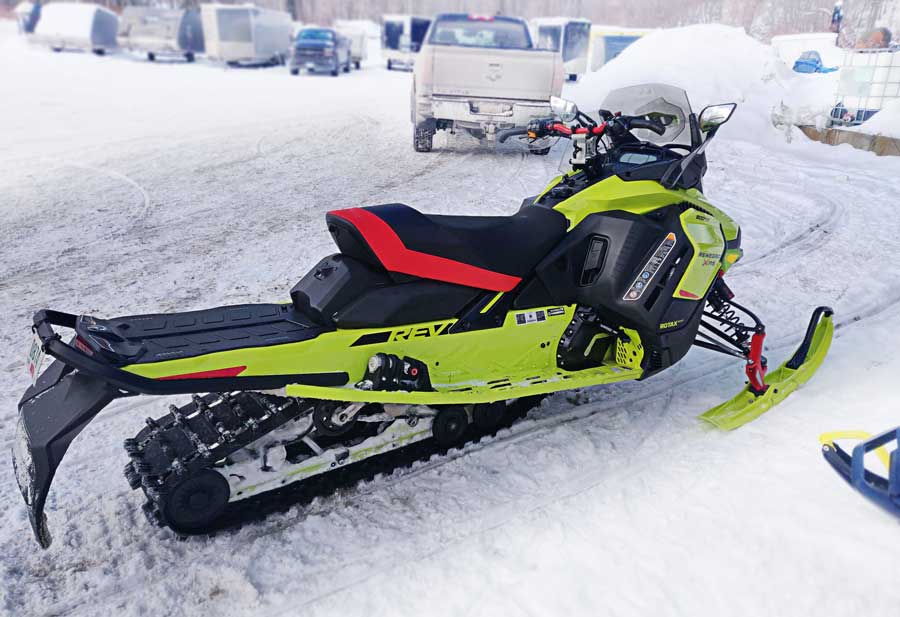
The two-stroke 850 E-TEC is lighter, with excellent run quality. As mentioned, I’m unsure of real-world mileage and that’s a huge consideration for touring when the gas stops are far away.
I like the fact that they added more durability features on the 850 and feel confident that the motor with proper care will last a long time. Check here for the Rotax 850.
One odd thing about wind protection surprised me. Even though the Backcountry had almost no windshield and seemed to sit higher, the wind did not bother me too much, I never felt cold. It was chilly that day, yet jumping on the Renegade Turbo afterwards felt cooler, even though it had a significantly higher windshield. Could the higher windshield cause more turbulence? Not sure. Check one for Backcountry.
Ski-Doo Test Results
In conclusion, my overwhelming pick would be the Backcountry 850, even though there are some minor shortcomings. The compliance of the rear suspension combined with the precision front end just plain rocks, it’s a game changer. In this humble writer’s view, it’s all about how you feel at the end of the day. If I feel fresh and less beat up on the Backcountry, then that’s where my money will go.
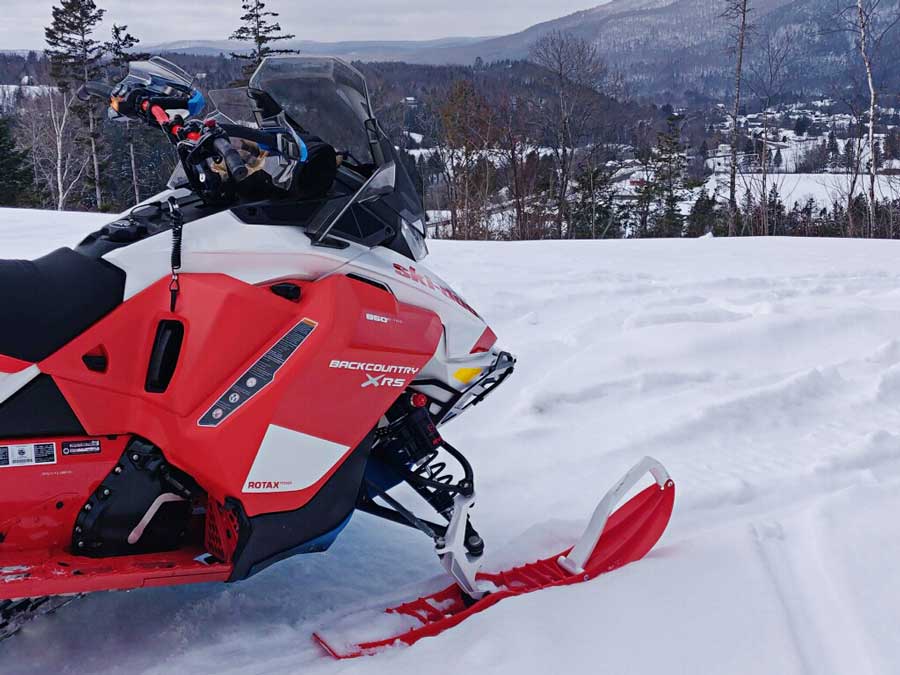
Carrying extra oil is fine, especially with the long track’s extra storage capacity. Interestingly, while on the demo ride, not once did I smell two-stroke oil at all. The foam quality in the small and narrow seat made up for the lack of size but I still would miss the heated seat.
I’d spec it out with traditional electric start instead of SHOT, as I do not want to pull-start an 850-anything at 30 below zero. As stated, I would go with the 1.6-inch Ice Cobra track.
Don’t get me wrong, the Renegade 900 Ace Turbo is an outstanding machine. It’s truly a formidable weapon and its merits cannot be ignored. I did call it a home-run last year and that hasn’t changed.
These snowmobiles have gotten so good we are now splitting hairs regarding which one would suit your needs the best. A bonus for consumers! Either way, you get a top-notch touring sled. Hope this helps your decision-making process.
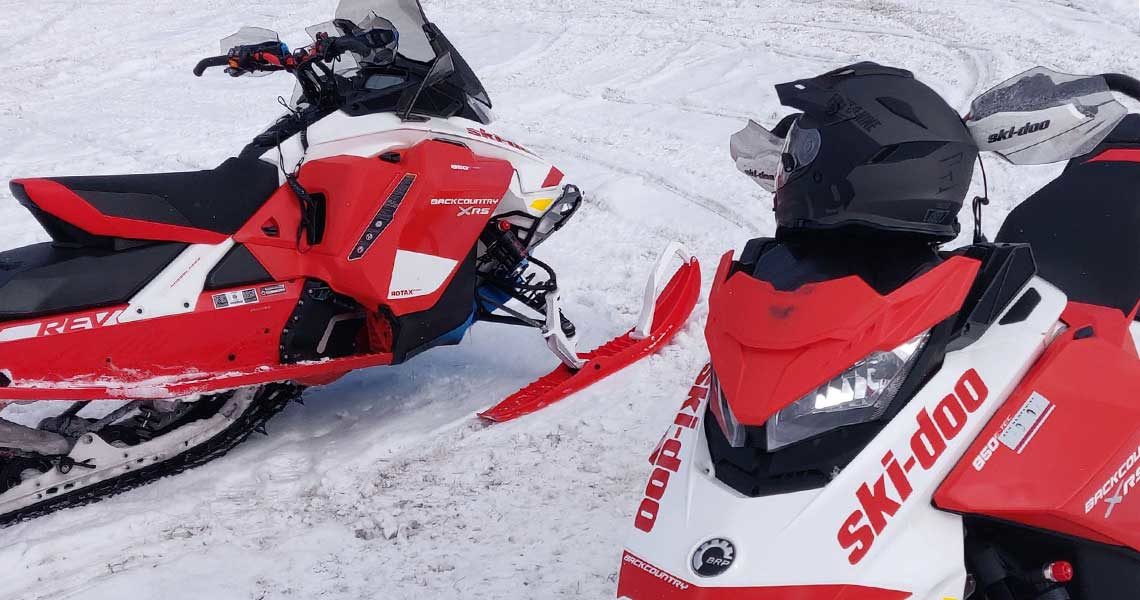
You must be logged in to post a comment.